The following are brief summaries of social movements around the world which have been repressed using tear gas. They represent only a small snapshot of some of the work that is happening on the ground, and they represent only those countries in which War Resisters League has been in contact with activists through the Global Network.
Below Movement Profiles are: Chile, United States, Egypt, Palestine, Greece, Bahrain and Canada:
CHILE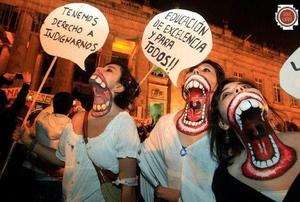
"The protest was for the re-nationalization of copper in support of education . . . I have asthma and [the tear gas] felt worse than the worst asthma attack I've ever had in my life." - Cora
The Chilean student uprising began to come together in May 2011 and was the result of various social tensions within Chile, among them low levels of public funding for higher education. While the movement has been led by students on the university level, high school students have loosely organized themselves alongside the demands of the movement at large. The largest representation of students is the Confederation of Chilean Students, which is made up of various universities’ student governments. Roots of this movement are often traced to the last year of the US-backed Pinochet regime, 1990, when the states’ role in education was vastly reduced to “regulation” paving the way a growing role of the business sector in determining state education policy.
The students are outraged as their education has become not a right, but a privatized commodity. During organized walk outs, marches, and protests, the students and their supporters have expressed their demands for increased state support for public universities and the call for justice in a society that is wrought with socio-economical inequality. This injustice is sadly not new to Chile. During the years of Augusto Pinochet’s dictatorship from 1973-1990, the country was under siege of brutal tactics of social repression and the adoption of neoliberal economic market policies that led to the privatization of basic rights, which is what led to these massive protests. These “reforms” were never fully reversed in the post Pinochet era, with the constitution drafted by the Pinochet regime still being in force today. These issues within the institutional framework of Chilean government prevent many of the demands of the general public from receiving just representation. Hence another demand of the student movement: the removal of the constitution created under the violent and repressive dictatorship. The student movement has been met by severe state repression during marches and protests. Hundreds of students have been arrested in clashes between the police and demonstrators. The police have heavily used “crowd control” tactics such as water jets and tear gas. Such repression was also very commonly deployed against indigenous peoples in Chile. Despite these obstacles students and other formations continue to fight for their right to equal public education and to see the end to the continuation of repressive policy from the dictatorship within their present “democratic” society.
On May 18, 2011, the Chilean government announced— in the wake of a study by the University of Chile which demonstrated that tear gas exposure may lead to miscarriages— that they would temporarily suspend the use of tear gas throughout the country. Latin America News Dispatch quotes then-Interior Minister Rodrigo Hinzpeter as saying: “[I]t seems reasonable to suspend the use of tear gas until new medical reports dispel any doubts about the appropriateness of employing these gases to confront situations of public disorder and vandalism.” Fortunately for the Chilean government— and unfortunately for Chilean protesters, such as the 30,000 protesters who, a week earlier, had gathered to demonstrate against the HidroAysén hydroelectric project and been faced with tear gas— the government found exactly the evidence they were looking for, from the manufacturers themselves! The Chilean government put together a report, three days later, citing US company Combined Systems International (supplier of tear gas to the Chilean police), arguing that tear gas was safe. The report, and the lifting of the ban on tear gas, came just in time for the state to use tear gas against the next round of HidroAysén protests.
UNITED STATES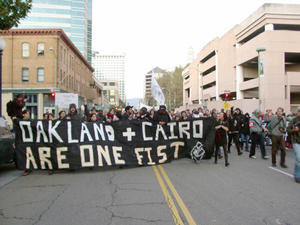
"The halls of a Pennsylvania high school are patrolled by numerous guards in uniform and plain clothes...and I've seen three students taken away in hand cuffs...During one incident, I was waiting with a book cart for the elevator. There were loud noises and students came pouring out of a nearby door followed by a caustic smell. There was shouting while the students stood in the hall, then a uniformed officer followed them through the door and the students bolted down the hall away from her. The officer was holding a student with one hand whose eyes were streaming. In the other hand she held a chemical spray container that she pointed at the students. I have been exposed to both tear gas and pepper spray in the past and could not tell you which this was, but even through peripheral contact I could feel my eyes begin to water and my throat burn." -Owen
Since the United States’ founding as a settler colonial state, it has used state repression against people within and at its borders, as well as exported that repression worldwide. Tear gas has played a particularly important role in that repression and in the movements that face it. Just as US chemists were responsible for the introduction of tear gas into war-making, it was also the US that introduced tear gas domestically as a common tool available to the police and to the public. The earliest documented use of tear gas use within the US was just after WWI, when it was installed in banks for release during a “disturbance.” It was soon made into a canister form that can be fired with a gun.
Tear gas was also used in 1971 when prisoners at the Attica New York state prison undertook a four-day uprisingduring which they took prison guards as hostages, calling for an end to the brutal and inhuman treatment they were receiving at the prison. In response, the state police dropped tear gas into the prison yard and opened fire into the smoke, killing 39 people. Tear gas too has been used as a police weapon against anti-war activists opposed to US wars in Vietnam, Afghanistan, and Iraq, members of the Black Panther Party, the Brown Berets, the American Indian Movement, and many other groups and historic movements for change.
In recent years, tear gas and pepper spray have been used against mass movements against free trade, neoliberalism, and capitalism in the US. In 1999 in Seattle, the largest convergence in the world of people organizing against globalization created a direct action powerful enough, along with those representatives from poor countries who were participating in the ministerial, to cause the World Trade Organization talks to collapse. Photos from the protests showed protesters sitting arm and arm with their affinity groups, refusing to be moved in the face of the massive amounts of the tear gas and pepper spray being used. Police also attacked protesters with chemical weapons at the Free Trade Area of the Americas summit in Miami, Florida (which followed the summit in Quebec City, Quebec in Canada in 2001) in 2003, operating within what has since been referred to as the “Miami model,” which relies heavily on the extreme use of tear gas and pepper spray, among other weapons used to injure activists, in order to break up the protests. The police chief behind the “Miami model,” John Timoney, has since been hired by the Ministry of the Interior of Bahrain to advise the ruling regime on how to quash the Bahraini popular uprising that has been ongoing since 2011.
More recently, the US people saw and participated in a mass movement called “Occupy,” in which beginning in September 2011, thousands of people across the US took up the call to occupy public space in their town, to call attention to the power of what the “99%” can do to resist the control of the “1%” over public land and resources. As the popular chant “the whole world is watching,” rang true, people all over the world sided with the Occupy movement as they saw protestors in Oakland, Sacramento, and Davis, California, as well as Seattle, Washington, and Portland, Oregon, get tear gassed and pepper sprayed during protests for economic justice and fair treatment. The Oakland police department bombarded activists with tear gas, including members of the Oscar Grant Committee Against Police Brutality and State Repression and Iraq Veterans Against the War, and one IVAW member was hospitalized with a traumatic brain injury caused by a beanbag grenade that was launched directly at his head.
The Occupy movement came on the heels of both the Arab Spring and the beginning of a wave of strikes in US prisons in 2011 and 2012. In July of 2011, approximately 6,600 prisoners across California launched a hunger strike in protest of conditions at the Pelican Bay State Prison, led by demands for their human rights. Similar strikes and protests within prisons have continued throughout the country, in places including Mississippi, Virginia, and Ohio. In Mississippi, a SWAT team came into the prison to detonate pepper spray and tear gas grenades during an uprisingthat reported involved 600 out 2,500 the total number of prisoners locked in there. Protests in the other facilities were met with tear gas, pepper spray, and beatings, all of which are common torture tactics within US prisons. Pepper spray is commonly used against prisoners who speak out against bad conditions.
We know that this is just the tip of the iceberg, so please tell us your US movement story.
EGYPT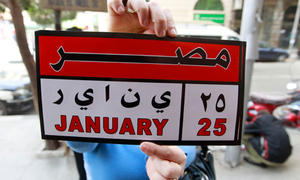
"I was gassed with CS gas in Tahrir Square on November 23, 2011. Blindness, skin on fire, utter panic. Down with SCAF, Down with the Police State, Justice for the Martyrs of the Revolution." - Samah
10 days after a popular uprising in Tunisia forced out President Zine El Abidine Bin Ali, on January 25, 2011, tens of thousands of protesters took to the streets of Cairo, as well as many other cities in Egypt. Protesters occupiedTahrir Square for weeks, culminating—18 days later and after much bloodshed and the death of at least 800 Egyptians at the hands of the police— in the successful overthrow of Egyptian President Hosni Mubarak. This uprising, and the years of struggle that continue to this day, would come to be known as the Egypt’s January 25thRevolution.
This uprising though, did not appear out of a vacuum. For years, several formations—from labor unions and students to politically motivated organizations such as Kifaya – The Egyptian Movement for Change had been networking and organizing to fight for “bread, freedom, and social justice” in Egypt. These demands, and the myriad actions and movements they fueled were to become central to the Egyptian movement.
Although the overthrow of Mubarak was a tremendous victory, the struggle for liberation in Egypt goes on. Since the fall of Mubarak in 2011, and especially since the election of Mohamed Morsi in June 2012, the Egyptian state has been typified by an ongoing power play between different powerful actors and institutions, as well as the ongoing resistance and determination of the Egyptian people. Some of these actors and institutions include: the military (controlled in large part by the Supreme Council of the Armed Forces or SCAF), the police (mostly controlled by the Interior Ministry), former higher-ups from the Mubarak regime, Morsi and his party (the Muslim Brotherhood), not to mention foreign powers such as the US and Israel.
Hazem Kandil argues that, under Mubarak, the Egyptian state depended on a “power triangle” which included the military, the police, and the political establishment. “The uprisings in January 2011 disrupted this delicate balance.”
The Supreme Council of the Armed Forces (SCAF)— the head of the Egyptian military— took over as interim leaders after Mubarak’s resignation. While the SCAF presented themselves as protecting the revolution, under their watch numerous police abuses continued, while the other demands, such as for economic justice, lingered uncertainly. Resistance against this repression erupted in struggles against the police and other security forces, most prominently“The Battle of Mohammed Mahmoud” in Cairo, November 19th -23rd, 2011.
This sparked a new wave of organizing, uprising and creative resistance. First, the Egyptian film collective Mosireen helped launch the Kazeboon (meaning “liars”) campaign to turn public squares, neighborhood cafes and street corners into cinemas to show citizen-made video footage of beatings and killings at the hands of the SCAF largely ignored by state-run television channels.
Soon, multiple movements against the SCAF military trials for civilians gained momentum. Since the SCAF assumed power, more than 12,000 civilians have been arrested, detained and tried in military tribunals. Bloggers, activists and anyone who publicly criticizes the SCAF is subject to this unlawful form of interrogation. Central to this struggle was the “No to Military Trials” campaign.
Another ongoing struggle is the ongoing sexual assault and gender-based violence used as a weapon to intimidate women from joining the movement. One element of the SCAF military trials for female civilians are “virginity tests”—where during the trial, soldiers sexually assault women to make sure that their hymen was intact. If it was not, they were subject to even more brutal treatment. (This video documents the various decentralized women-led efforts to combat this and other types of violence against women.)
Mobilizations calling for “bread, freedom and social justice” as well as confronting ongoing police abuses and US complicity in that repression continue to simmer and boil to this day.
US Involvement
During Mubarak’s regime, Egypt was the second largest recipient of US foreign military aid per year. Many of the weapons that Mubarak’s thugs used against the demonstrators during the overthrow of Mubarak were purchased from the United States, using US taxpayer dollars. These weapons include non-lethal weapons, such as the teargas used to disperse crowds that were explicitly printed with “Made in the USA.” Though the United States scaled back aid to Egypt after Mubarak was overthrown, they recently decided to reinstate it at its full value.
International Solidarity
In addition to the many solidarity rallies for the Egyptian Revolution that happened throughout the world, activists in the United States protested outside of the Combined Systems, Inc teargas factory in Pennsylvania and demonstrated against Point Lookout Capital—the majority shareholder of weapons manufactured by Combined Systems, Inc. In this way, these activists were recognizing their role and responsibility as Americans supporting the regime.
PALESTINE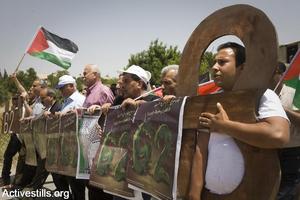
"My friend Mustafa (28) was shot by Israeli soldier from few meters distance with tear gas canister into his face. Mustafa didn’t survive and died the next day. His bravery inspire us to continue marching to our freedom." - Maath
In 2001 Israel announced the beginning of the construction of what it calls a ‘security fence’— better known as the apartheid wall— in the occupied West Bank. This wall supposedly creates a ‘security’ barrier between the state of Israel and the occupied West Bank; however, for Palestinians living in the West Bank, the wall has represented a massive land grab by Israel. The wall effectively swathes the West bank, cutting farmers off from their fields, cutting villages off from their water supply and other vital resources, demolishing Palestinian homes that stand in its way , severely restricting Palestinians’ freedom of movement and isolating villages from each other, and in some case dispossessing Palestinians of more than half their land. (For example, in the village of Qalqilya, which is almost entirely encircled by the wall: “Palestinian property within 35 meters of the wall has been or will be destroyed by the Israeli army. This includes homes, farms, agricultural land, greenhouses and water wells… Residents of Qalqilya are imprisoned in the town, cut off from neighboring Palestinian villages and the rest of the West Bank. Given that 45% of the city’s economy relies on agriculture, land and water confiscation has coerced migration of Qalqilya’s residents.”) It is imporant to note that long before the Wall, Israel has been continusously dispossessing Palestinians of their land, their homes, and their lives. Before the 20th century, all of the land between the Jordan river and the Mediterranean sea was Palestine. The state of Israel was created out of what is known as the Nakba (Arabic for “catastrophy”). The Nakba was an act of ethnic cleansing that resulted in the forced expulsion and dislocation of about 750,000 Palestinians and the eradication of over 400 Palestinian villages. The newer tool of the apartheid wall represents just one of the latest attempts by the state of Israel to displace Palestinians.
Palestinians have actively fought to resist this latest form of colonial dispossession since the beginning. The moment the Israeli state made known its plans to construct the wall, villages and communities in that wall’s path began to mobilize. Ever since they began around 2005, demonstrations in the villages of Ni’ilin, Nabi Saleh and Bil’in, to name a few – protesting a wall—have been met with fierce militarized repression. Popular Committees were formed in different West Bank villages to organize various forms of resistance. “These diverse, non-partisan committees lead community resistance to Israeli occupation in various forms, such as marches, strikes, demonstrations, direct actions and legal campaigns, as well as supporting boycott, divestment and sanctions.” Activists from these different committees banded together to form the Popular Struggle Coordinating Committee, which “was formed to facilitate fruitful communication between the different popular committees: from the villages of Bil'in, Ni'ilin and alMaasara - known for their struggle against the wall - through the many villages of the Jordan Valley and South Mount Hebron - facing attempts of creeping ethnic cleansing to Tulkarem, Nablus, Qalqilya and West Ramallah – who all suffer and resist the various aspects of the Occupation. The committee aims to provide a base for strategic thinking on a wider scale, while retaining the independence and uniqueness of each popular committee.”
American Teargas
Teargas is one of many forms of “non-lethal” weapons (along with live ammunition), which Israel uses against West Bank protesters, in order to ensure the continued expropriation of Palestinian land. Much of this teargas is manufactured by American companies. Combined Systems— an American corporation, based in Jamestown, Pennsylvania, whose teargas has also been used by the governments of Egypt, Tunisia, Yemen, and Chile, to crush uprisings there— is the primary supplier of teargas to the Israeli government. Another US company known to supply the Israeli government is Casper, Wyoming based Defense Technology, Safariland, and Federal Laboratories, which are all owned by UK-based conglomerate BAE systems. (For more info click here, here, or here.)
Stories such as Maath's, told above, have tragically become more and more common in the West Bank in recent years, as many Palestinians have been killed or seriously injured by the close-range firing of tear gas canisters manufactured by US company Combined Systems. Maath's friend, Mustafa Tamimi, of Nabi Saleh died in 2011 after half of his face was shot off by a Combined Systems tear gas canister. In Bil'in, Bassem Abu Rahmah and his sister Jawaher were both killed by tear gas canisters, in 2009 and 2010 respectively. The number of deaths as well as serious injuries as a result of teargas cannisters has drastically increased since 2008, when Israel began using Combined Systems’ “extended range” 40mm cartridges, sold under the brand name “Indoor Barricade Penetrator,” and which travel at a velocity of 122 meters per second and are designed to penetrate buildings. Although the manufacturers’ labels clearly indicate that the teargas grenades are not to be used at short range and are not to be fired people, this has not stopped the Israeli military from doing so— effectively turning these canisters into large bullets. (For more info, check out the B'Tselem report, page 8. To see the manufacturer’s website for the Indoor Barricade Penetrator, click here.)
GREECE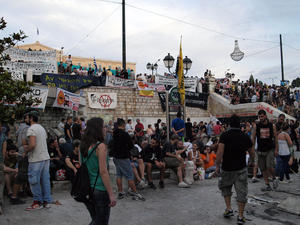
"2 years anniversary from the killing of Gregory, (Alexandros Gregoropoulos) a 15 year old, killed by the police in cold blood. People in Greece gathered to demonstrate, to Gregory’s honour . . . The gas was so strong that in a few seconds I had difficulty in breathing. I started coughing. I spit again and again so I would not swallow the poison that was all around us. The skin on my face was burning. People started to brake the 'chain lines.'" - Tina
In 2008 a massive uprising began in Greece after the Athens police murdered 15-year-old anarchist Alexandros Grigoropoulos. The following several weeks saw huge demonstrations against police brutality in the streets of Athens. The uprising, which was largely anarchist, sent a shockwave around the world, with solidarity actions held at Greek embassies and consulates in various countries. The Athens police responded with violence, and as a result, within less than a week, the entire country ran out of teargas. Greece issued an international call for more, especially from Germany and Israel.
In 2010, another uprising began as protesters took to the streets to protest austerity. France, Germany, the EU and the IMF have been instrumental in forcing austerity on Greece— further devastating an already devastated economy. (While the austerity measures have forced the Greek government to cut government spending from virtually every sector, special exceptions have been made requiring the Greek government to continue purchasing French and German weapons.)One popular slogan in the Greek uprising has been to say that the “junta never ended.” This is a reference to the brutal dictatorship of 1967-74, which was backed by the US and western powers as part of the cold war. A tactical advantage that protesters have had in Greece is the fact that the police and the military are forbidden from entering any public University campus. This is because of the Athens Polytechnic Massacre in 1973, when, responding to a student occupation at the Athens Polytechnic, the forces of the CIA-backed military junta sent in a tank, crashing through the main gate of the university, and proceeded to massacre the students. This legal protection has been used by various protesters, and has allowed social movements to flourish. For instance, in 2011, 300 undocumented migrants occupied the Athens law school where they staged a hunger-strike.
As the economy has taken a turn for the worse, spurred on by French and German austerity and the Greek governments’ complicity in this regime, some have taken to scapegoating immigrants. Tragically, assaults and murders against immigrants in Athens are becoming increasingly common, and the neo-Nazi party, Golden Dawn (whose leadership has ties to the leaders of the junta) gained 18 percent of the vote and 7 seats in the Greek parliament in the 2012 election. It is rumored that about 50% of the Athens police force may have voted for the party in the election, (although some doubt this figure) and stories have circulated that the police have referred people who call the police to the party. Golden Dawn’s central platform has been the scapegoating of immigrants. On August 9th, 2012, the Athens police conducted a raid in which they rounded up and arrested thousands of people suspected of being undocumented immigrants. Included in the raid were 25 transgender women who were arrested and forcibly administered HIV tests— simply for being transgender. Adding insult to injury, the operation was, ironically, named “Xenios Zeus” after the ancient god of hospitality.
Since 2009, the vast majority of undocumented immigrants entering the EU— about 90% of annual arrivals— have been coming through Greece. Many of these immigrants— including the significant Afghan diaspora— are refugees of American wars. The combination of a growing financial crisis, the rise of the far-right, an overburdened and failing government bureaucracy, have resulted in a disastrous situation. Vastly overcrowded immigrant detention centers have been condemned by the EU; however, these conditions have also been created as a result of the EU’s racist immigration laws, and austerity has meant that the Greek government couldn't afford to do anything about it even if they wanted to.
Despite all these attacks, immigrants have continued to mobilize in Greece, organizing their own movements as well as taking part in the larger uprisings. In 2008, during the height of the uprising, a group known as the Athens Haunt of Albanian Migrants released a statement titled “These Days Are Ours, Too,” signifying that the uprising belonged to immigrants as well as non-immigrants. As mentioned earlier, In 2011, 300 undocumented migrants living in Greece, mostly from Tunisia, went on hunger strike to demand concessions from the state. During part of their hunger strikes, the migrants occupied the law school at Athens University. Although the strikers were evicted by riot police from the campus, they were eventually successful, after 6 weeks of hunger strike, in getting concessions from the Greek state.

BAHRAIN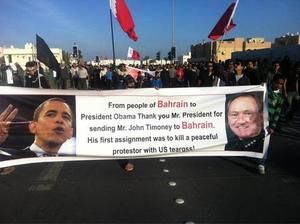
“Sitra - Bahrain 6/7/2012: ‘Eye for Freedom’ March repressed by tear gas and shotgun bullets” - Anonymous (translated from Arabic)
Since February 14th, 2011, Bahrain has been witness to a mass uprising. Inspired by the several neighboring uprisings in the Arab world, protesters have been demanding political and economic reform, and often the downfall of the regime. These demands include constitutional reformation, the formation of an elected, representative government, and an end to corruption, which is widespread in the kingdom.
Bahrain maintains a monarchical system ruled by King Hamad bin Isa Al Khalifa and and elite political class often closely tied to the al-Khalifa family. The monarchy has a history of silencing the dissident voices of the population through methods of torture, detention, and in the phrasing of a comprehensive Physicians for Human Rights report “weaponizing tear gas.” These actions have led to an increase in global attention, along with increased inquiry into Bahrain’s excessive use of force and human rights violations.
After the protest in the capital city of Manama and across Bahrain, King Hamad declared a State of Emergency for 3 months, effectively removing the protesters from their camp at the centre. The declaration was supported by theforeign military intervention of Saudi troops on March 14th. This crackdown however, did not crush the uprising, but rather decentralized it, breaking it up to myriad village-based movements, such as in Sitra and Durz. Once the State of Emergency was lifted, various political groupings, most prominently the Coalition of February 14th Youth, began to organize weekly protests of tens of thousands of opposition activists. The police response to these peaceful and unarmed protesters has been brutal. (In a campaign of intimidation ran by the police, there have been several house raids in Shi’a neighborhoods, beatings at checkpoints, denial of medical care, as well as detention and torture. Oppostion figures though, cross Bahrain's geographical and sectarian communities, as the diversity of the movement has consistenly shown.)
A report released by a commission of inquiry established by King Hamad in June 2011 has confirmed the Bahraini government’s various violations of human rights and have silenced government claims that the protests were instigated by Shi’a Iran. Around the time of the report Bahrain sentenced several prominent movement figures to life in prison, including Abdulhadi al-Khawaja.
Since the beginning of the twentieth century, there have been sporadic movements demanding economic, social, and political rights. Since 1783, Bahrain has been ruled by the Al Khalifas. Bahrain became an independent state apart from the British protectorate in 1971. The first parliamentary election took place in 1973. The constitution and the assembly were dissolved two years later. The year 1992 saw a popular uprising demanding the return of Parliament and constitution. King Hamad bin Isa Al Khalifa muted the uprising in 2001 with reforms that were supported by an overwhelming majority of the Bahraini population. However, the following year, the government issued a new constitution appointing the majority of power to the upper half of Parliament as opposed to the popularly elected lower half. This led to the boycott of the 2002 parliamentary elections by many opposition parties, yet in 2006 Al Wefaq won a majority vote. This created a split in opposition associations, with organizations such as the Haq Movement seeking change outside of that brought about within Parliament. Since then, tensions and repression have increased dramatically, culminating in the ongoing mainly decentralized revolt. The Bahraini revolution continues . . .
CANADA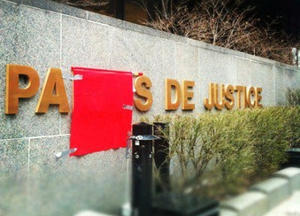
“I came with a group of students who are protesting against a proposed 75% tuition fee increase, also referred as the Red Squares Movement. Marching with us where Innu Indians and environmentalists. Things rapidly went wrong after protesters tried to enter the convention center . . . For the first time of my life, I felt agressed in my liberties.” –Olivier
In March 2012, Québec’s Premier, Jean Charest, announced a 75% tuition hike for all public university students. Many current university students in Québec are first generation college students. Most of them are working their way through college—a dramatic tuition hike means taking on a second job or enormous amounts of debt.
As a result, students decided to go on strike—abstaining from attending their universities en masse to protest the hikes. Students pinned red squares to their lapels—or wore them as earrings or face paint—taking to the streets, demanding negotiations to end the tuition hikes. Students—now protesters—would take to the streets each night—banging pots and pans (les casseroles)—chanting “Manif chaque soir, jusqu’a la victoire”- Protest every night, until victory.
When it became undeniable that the students were serious, the now notorious Montreal Police (SPVM) began implementing the Emergency “Law 78”—a law that actively criminalized unannounced gatherings of more than 50 people.
Law 78 transformed what was once a focused student strike into a popular movement. Solidarity actions erupted throughout the world. Though to others a $1625 tuition hike seemed cheap in comparison to other attacks on public education, police repression and criminalizing of the people’s voice was something that echoed throughout the world.
On the largest nights in May, more than 400,000 marched through the streets of Montreal.
The police responded with violent force—using smoke bombs, stun grenades and tear gas to intimidate the crowds and make mass arrests. Protesters were beaten, shot and in some cases hospitalized and permanently injured. Journalists trying to get into Montréal to report on the movement were detained at the border. Anyone wearing the carré rouge (red square) in public—even if they weren’t at a protest—was subject to police interrogation.
It became clear that the police were trying to crush, intimidate and silence the movement and would use any means available to them. It was also clear that the police were the soldiers of the state—a state with a neoliberal agenda motivated by profit that has no interest in serving the people.
It became clear that—like so many police forces throughout the world—they were willing to beat, gas and silence other people into submission. Only to find the following August many students saying: “Back to school means back to strike!”



